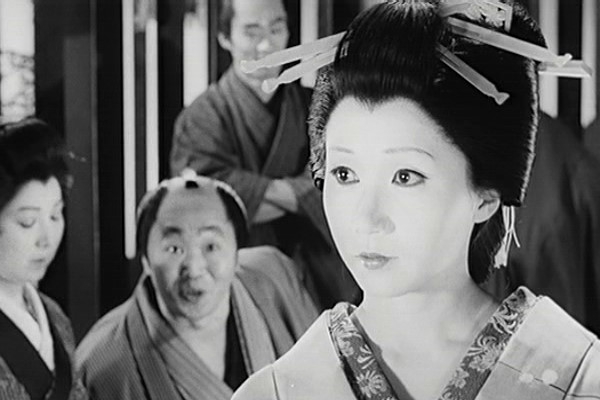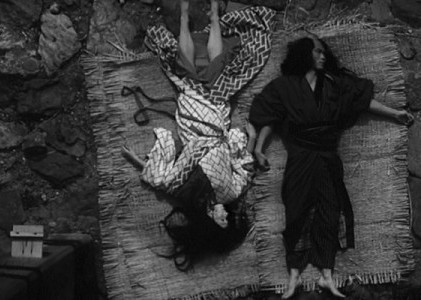Bridging the Centuries
Unable to conduct an in-person interview with Masahiro Shinoda, halfway across the world, I had about 30 questions of all sorts sent to him via email. I suggested that he could look them over in advance and, once he sat down with a translator, just pick a few that interested him to discuss at length: as a current professor at Wasada University, he could give an impromptu lecture on his own films. Shinoda very generously, and very graciously, sent back via email an audio recording of a completely openhanded 80-minute monologue (with breaks for translation), weaving between a few important points of reference, including a picture-scroll from his own collection, and often responding to multiple questions in single topics and lines. I've left out my original questions, almost all of which were addressed, and which are now implicit in the responses.
I'm extremely grateful not only to Mr. Shinoda, but to his interpreter, Okura Yoshiko, and especially to Ishida Satoko, my Shochiku intermediary who not only arranged the interview, negotiated the details, and translated and communicated my written correspondence to Mr. Shinoda's office, but also has been extremely helpful at every step in assisting me with information and materials. —DP
Masahiro Shinoda: As you know, the original script for the film [Shinju ten no amijima (Double Suicide, 1969, adapted from Chikamatsu] comes from ningyo joruri [puppet theater, or Bunraku], and has been staged and played many times in many forms by people—and puppets. But in my research, I found that the scripts used for production were, in fact, rewritten many times and had lost their original sources. And in a way, for us to accurately restore the classicism of the original material of the 17th century was a way for us to rediscover the art of the 17th century in our own time. This was an idea I had developed from the 1950s, from before I was a filmmaker, but since I'd become a director I had always wanted to do this: to show the original Chikamatsu as it was written, not the versions that had been revised to suit more musical versions of the production over the many hundred years.
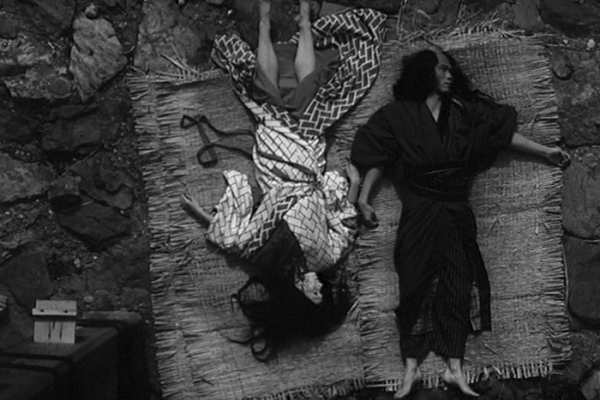
Double Suicide
But despite my idea, this was material that definitely wasn't suited for mass consumption. The mass audience for a film at the time had no interest in this type of material, especially set in the Edo era—and Kabuki and film by this time were very different mediums of art. And there were no producers willing to take on the project either. I had been, as you know, at Shochiku studios, which are also producers of Kabuki, and where Ozu, of course, had worked. And I myself, like Oshima, had become independent from Shochiku, in order to make my own films for the audience, especially for the intellectuals among the public. The motivation was, why not make films for the intellectuals? And so I found myself in a situation where we had a dramatically low budget, but a dramatic freedom to make films, and this was the beginning of ATG, the Art Theater Guild. We found ourselves able to choose what we wanted to make, without the financiers' meddling. And this situation was really very much a miracle. But again the budget we were able to work with was dramatically low.
As a result of this, my film became very theatrical, as an expression, because obviously we did not have the budget to use big sets, outdoor sets, and to build them, and we obviously did not have the technology, CGI, that would enable us to recreate the period, like we can do now. As Oshima and Yoshida, I believe, did, we were working in a limited space directing actors in a very symbolic way.
In the 1960s in Europe, there was a conceptual movement called the Black Theater. The idea was to find ways to put on a play without any art, without any production design or devices, to recreate the quintessential world of pure theater only by use of words. And I had heard about this, and in Japan, I had actually seen a stage play take on a similar sort of challenge. Around this time, I had also come upon Toru Takemitsu's radio play of Shinju ten no amijima, and because it was over the radio, the sounds I was hearing, the voices, seemed like they were coming from this place of darkness: they almost had an operatic power, a hold, a resonance. The film I had wanted and Takemitsu's radio drama: there was something there. And like the fatal aspect of the story, and because there was a realism I wanted to have in the film, it was something I couldn't run from. But as I said, I only had a limited budget for my expressions. So I couldn't build huge houses, or a red light district, for this film. I decided to use kuroko stagehands as my intermediaries.
Now in ningyo joruri, the kuroko, the ones in black, are of course the ones who manipulate the dolls. But in my film these dolls were going to be played by actors. So when it comes to film, you actually see people who are playing the kuroko, who are also manipulating, or pushing along, the stories and the characters within the film. But I wanted these elements to come together in the form of cinema, not theater, so I came up with the concept that the hands, the fingers, of the kuroko are in fact those of Chikamatsu's, the author's intention. He was very ambitious, and I saw this as him being ambitious enough to dominate even the destinies of the characters in his play, so in fact when you see the kuroko's hands, those are the hands of Chikamatsu's intentions, those of the unseen god, those of destiny. And I thought by materializing this to be seen, the audience would be able to see the author's, or the filmmaker's, or the artist's intention. So just by watching the film with this device, you would not only get the fictional drama being created, but the intention of the filmmaker, of the artist: why this drama was created, why the characters were moved this way. And the audience would be able to see all this. This is definitely something that can only be done in the territory of film. And again, to explain it again, I basically took away the rule in puppet theater that the kuroko must not be recognized as any force within the fictional world. And by taking that away, I thought the audience would be able to confront the author, or the filmmaker, or the artist themselves.
The prologue of the film was such a hard thing to overcome in the making of this film. I discerned the roles of the kuroko in the puppet theater, and I took them out, and I made them gradually guide the actors, and that became the introduction of the film. And I was also going to lay the opening credits over this sequence, so we decided to have music scored for this scene. But in fact on the day of, we didn't have the music yet, and it was Takemitsu who told me to call the screenwriter Tomioka Taeko and to recreate our discussion about the last scene over the phone—and to record that and use it for the music of the scene. So this particular music was in fact the screenwriter and the director with their imaginations in exchange, and this whole idea was in fact not mine, but Mr. Takemitsu's. This kind of spontaneity was something I experienced throughout the making of the film, and in all sorts of different sections and stages. Some of it came from proposals from the actors, and the crew, and some were very surprising, and so for the entirety of the film I had no storyboard at all. And every scene I took with one take—and David, I know you had a question about the montage sequences in my earlier films, but here I attempted to do long takes, as long as Mizoguchi's.
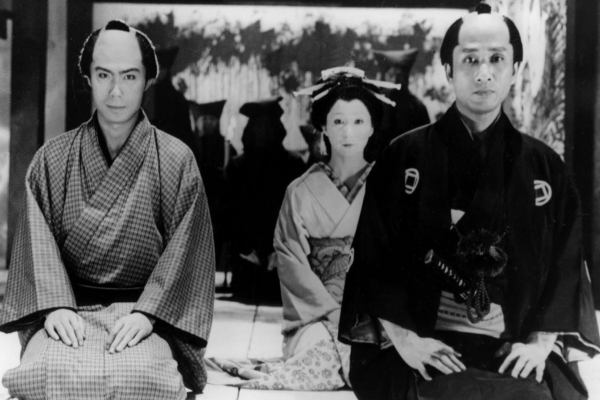
Double Suicide
Because we, the artists, auteurs living in the 20th century, were going to tell the story of a love affair taking place in the 17th century in Osaka, and because we were not just approaching the play, but approaching it through the author, Chikamatsu, and approaching it through his inner landscape, I feel the way we were able to bring the classic into modern times was itself a trip, and one that left very different tracks from the normal way you would recreate a classic for contemporary times. Now in terms of music, Takemitsu completely denied the use of any kind of instrumental music that would traditionally be used in Kabuki or a puppet play, and his main keynote was to be the gamelan music from the Indonesian island of Bari, and also the pipes and flutes and drums of Turkey. And the effect, toward the end of the film, as they press down on the story, and attenuate the story, is completely the opposite kind of music than that of a Kabuki production.
Mishima had committed suicide in 1970. What my peers, Oshima and Yoshida, were experiencing, I hope you can discern from their work. For me personally this was the climax of the prosperity that Japan had experienced. And this was of course partly due to the fact that we were occupied by a big, strong country like America, and this was the conclusion that we as a society, a country, were coming to, that Japanese culture had become localized. There were not many people at the time who could even read Shinju ten no amijima in its Chinese characters. And I felt I had seen this landscape of a culture deteriorating; many skyscrapers were being erected in the city at the time. When you would go out, the sense of life as something optimistic was overwhelming. The Japanese identity, for me, though, of the time, seemed to be disappearing.
And this was the feeling that was very prevalent in me even when I directed Pale Flower. We were on the brink of a new era, of IT, high technology—and committing shinju for love in the 17th century was in fact something that happened in Osaka in reaction to what were, perhaps, the first displays of capitalism in Japan. And within me I felt that this was maybe a foreshadowing of what would happen to our own capitalism as a country, that this was the capitalism we would have to face in the future. And so the tragedy that the independent small business merchants suffer in this film was the tragedy that I felt that we were about to, or would eventually have to face in Japan.
Now you have a question about why I pursue beauty, but that I wanted to make my films as elegies to those who fail and collapse was something I already recognized within me at this point. This was quite intentional when I chose the theme of shinju here, because my intention as an artist was to strike outside of the confines of society, to become an outsider—to put it in beautiful language—to become a filmmaker and do my work there. And this was before I was 40, but to become an outsider, to make a film there, was probably something I wouldn't have been able to accomplish if there had been a studio producer looking over my back.
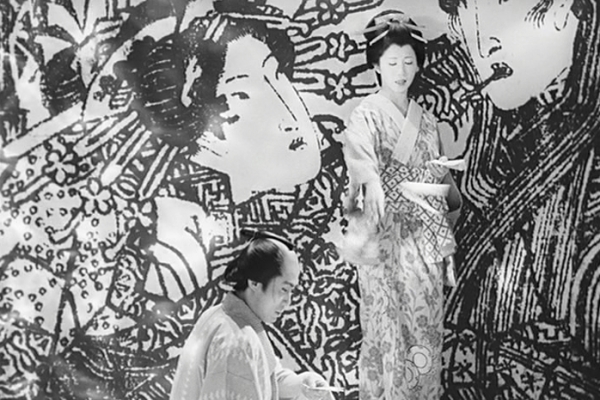
Shima Iwashita in Double Suicide
Yari no gonza [Gonza the Spearman, 1986; Shinoda's second Chikamatsu adaptation] again is a film that takes place in the Edo era, when the shogunate is established, when the Bushi soldiers are no longer able to use their source of livelihood, their swords. And this was also an allegory of the time when the film was made, because in our constitution, we had to abandon all forms of self-defense as a country. Now the Japanese love golf. And the golf clubs are there to replace the swords that the Bushi warriors would carry.
Looking back in hindsight, Mishima had written an essay about how in theory we would have to defend our country by means of culture if by law we were not able to use force anymore. And as he wrote these essays, I saw these samurai swords, which in the end he used to kill himself, were being replaced by golf clubs.
From ancient times to the middle ages in Japan, the Japanese as a race would often use decapitation in battles and wars.
[Here Shinoda pulls out a book with a print, from Go Sannen Kassen Emaki, a picture scroll from 1087 that unfortunately can't be included here due to rights issues. Along with a riding warrior and a tree, the emaki depicts three racks of decapitated heads, a few fallen on the ground, as if hung like modern laundry.]
The backstory of this picture is an Auschwitz of a kind, in that particular headhunters from the Northeastern part of Japan had risen to strike against the establishment, where they were countered by a force that surrounded the capital. And they were all killed, and their heads were left to be exposed.
In ningyo joruri, the doll, or puppet, is called the kashira, which also means "head" in Japanese, so the expressions of each of the kashira becomes of course the main theme and story of the production. This ningyo joruri came about around the same time that Noh had come into the Japanese history of entertainment. Noh of course is a stage play where masks are used in a similar manner to the kashira (dolls).
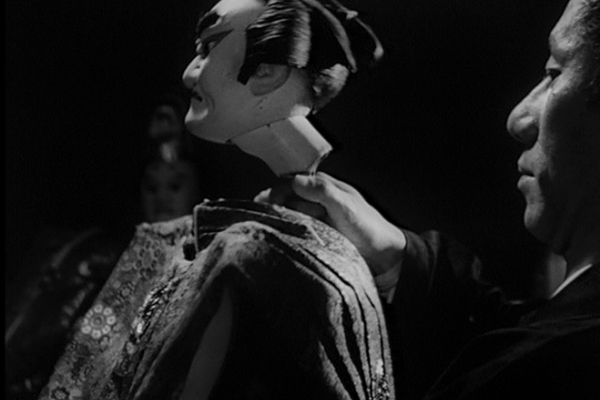
Double Suicide
Now I am, of course, aware of many decapitation stories in other cultures, those associated with the guillotine in the French revolution, Marie Antoinette and so forth. In Japan, though, even apart from the many political instances where warriors were beheaded, there were many stories also of soldiers or samurais decapitating their children's heads to cover for their master's child, or for their master. By the arrival of the Meiji era, Japan had stopped their tradition of decapitation, but within the traditional Japanese theater, we still see this tradition continued in the form of use of kashira and the masks. And I feel hara-kiri is very closely connected to beheadings as well. Because in loyalty through death, or virtue through self-sacrifice, within this act, I feel the Japanese concept that mortality's an illusion.
In contemporary Japan since 1945, the Japanese people have not killed anybody—not one person—through the act of war. It might be the only country that has managed to do this. At the same time, every year we see more than 30,000 people kill themselves, while traffic accidents, which were born out of motorization in modernity, have gone down to 10,000 a year.
There's this feeling that you are inadequate or unable to show your true colors in your work, in your company that you work for, in your family that you look after, or in your society, to the extent of taking your own life. The act of dying in war that's always been celebrated, because in a way you're doing it for your country, is no longer there: these suicides are probably a new Japanese experience that show how repressed we are in contemporary times.
Occasions and opportunities to help you enjoy your life, like Christmas sales, all sorts of discounts, Disneyland, have been imported into Japan. But on a personal level, these Americanisms are impossible for me to feel optimistic about. And I am unable to find beauty in the death of these 30,000 people who were suicides. For me, this has to do with the idea of how to die beautifully. And it is because of this beauty that I find myself interested not only in people who actually go to the lengths of dying, but those who are on the way to death, or being corrupted, or failing and falling apart. The victors are always arrogant. But losers lose with a great amount of imagination. And I think that in this sense, the losers are closer to cinema's own possibilities of imagination.
In Shinju ten no amijima, my wife and actress Shima Iwashita played two roles, and of course the reason isn't because I didn't have the budget to get two actors for the role, but because my perception of women is that of woman as a prostitute and woman as a wife: and essentially, I believe, this is the same thing. Now in the Western world, you would take an actor and talk about their characteristics, say you take the two Hepburns, Katherine and Audrey, and say that they're different. But for me, they're both Hepburns [laughs]. For men, it's nice to have a woman in the prostitute mold and a more loyal wife—and while you can go to whichever you like, for a man to be close or drawn to a woman requires Eros. If you were looking at a woman and trying to choose, or show her in the light of morality or that of Eros, I would feel very uncomfortable having to choose the former as a standard to use to talk about, or describe, or portray her. And this is because I have a mother complex: my mother for me is the eternal woman. My mother was very wise as a person, and I have great respect for any woman who is able to bring up a child: women by nature are gifted with the ability to have children, which I fundamentally have great respect for, while men, on the other hand, for me are only objects I can fight. Now in Shinju ten no amijima, my wife played Oharu, who of course is a prostitute and figure of Eros, and Osan, who's a more domesticated wife character, and I think these two are the motivations for men to love a woman: and this is the only thing I'm interested in in this subject.
Shima Iwashita in Double Suicide
I lost my mother at the age of 22, and the loss was so great that I almost doubted the existence of the world around me. I recently, as you well know, have written a book and have received a Kiyoka Izumi award for it: a book I wrote on the history of Japanese theater. Interestingly Izumi also lost his mother, at the tender age of nine: his mother's name was Suzu, which in Japanese is the sound of the bell ringing. Later when he got married, his wife had also by law the same name, Suzu, and was a geisha. Of course his work was the basis for my film Demon Pond, by which time I had revisited his works for the film, and had discovered that in childhood he went through the same emotional experiences I went through, in losing our mothers, and I think the ghost of Izumi is what shone a light onto my book that led to this award. By now, you probably think I'm quite into mysticism, but that's not quite true.
In any case, I feel more strongly that I've been given blood by my mother than my father, and I think this sense has to do with Japan being an island country, where fathers can move around freely, but mothers have to stay very close to home. And I think because of this, our country is traditionally very much a matriarchy. Now thinking about that and looking at cinema, which was born in the 20th century in France and went to America and became this huge industry, America's of course a country that sought independence from England, and the idea can be seen in—or has strong ties to—American westerns and genre films.
But when you look at Japanese cinema, though, I don't feel that it started in the 20th century, because, say, you take a film like Ugetsu, by Mizoguchi, there's a beautiful woman, in this case played by Machiko Kyo, who lures a man and turns out to be an evil spirit. When we look at the motifs of the film, the story actually harks back to the middle ages in Japan, and that has very much to do with the history of theater in Japan. And in this sense I feel that Japanese cinema and the history of it is very different from that of world cinema, and this is also something you'll be able to discern from Kurosawa's Seven Samurai.
Now the younger filmmakers in Japan that are making so-called J-horror films are the successors of the Ugetsu tradition, if you will. And in The Seven Samurai, the character played by Mifune, the local farmer dreaming of becoming a samurai, is very much the Taro-Kaja character that's seen in Kyogen in the art of Noh. Now when they made their films, Kurosawa and Mizoguchi, perhaps unconsciously within that postwar environment, had to lean on Japanese tradition, because they knew that they weren't Americans. And so their films had a sense of Japanese tradition, but my films I approach more from a rational than mystical point of view, based on my own very real confrontation with a postwar society. And that's where I come from as a filmmaker.
My views and perceptions of women, or feminism, come from my mother, as I was telling you. But when it comes to my father, I felt that I could study him: a father is more of a social being that is linked to the more political fate of a nation. And the mother, by contrast, is an eternal sort of lifeblood that symbolizes it. And I think directors like Oshima and Yoshida were trying to create films from a more rational, patriarchal approach to their filmmaking, whereas I was probably trying to make films from a more motherly approach, where sometimes things would not be able to be explained only rationally. We have the term Japanese New Wave, but you can't brand us by one label.
Now as you know, I have retired and announced my retirement from filmmaking. And I am researching currently the junction between Japanese entertainment and contemporary times, and the relationship between these two, which I'm very drawn to. My current book attempts to break down theater through anthropological and historical points of view. But this particular field is barren, it's a wasteland. I still hear the sounds of the camera rolling, the voices you hear on the set, and the crew and myself running around: that vision, that space, is something that hasn't disappeared inside me yet. It is almost as if I had pulled the brakes on a locomotive while the train is still moving, and now it's riding on the rail. And whether the engine will be started again on this living train, and whether I will return from the barren wastelands of the academics to the more civilized world of film, remains to be seen.
And this is my answer to you, David, whom I haven't had the pleasure of knowing yet. ![]()
LATEST ARTICLES
-20140814-173707-thumb3.jpg)
Fighting Words
by Imogen Sara Smith
posted August 12, 2014

Fighting Words, Part 2
by Imogen Sara Smith
posted August 20, 2014

On the Margins: The Fil…
by Andrew Chan
posted August 12, 2014

Robin Williams: A Sense…
by David Schwartz
posted August 12, 2014
 Bridging the Centuries
Bridging the Centuries
THE AUTHOR
David Phelps is a professional interlocutor and voice-over artist.
More articles by David PhelpsAuthor's Website: minuteone.tumblr.com

